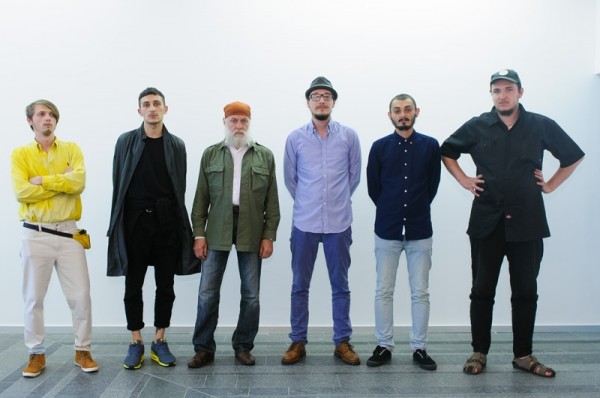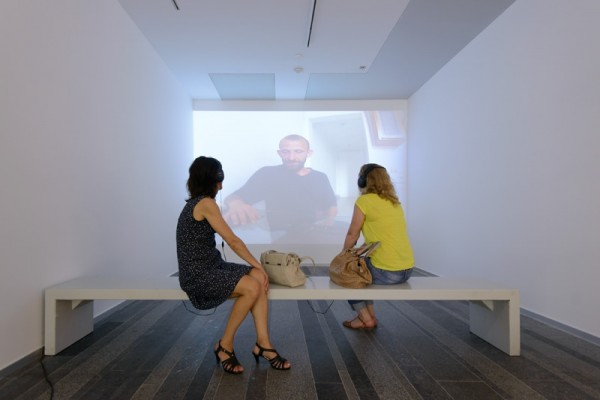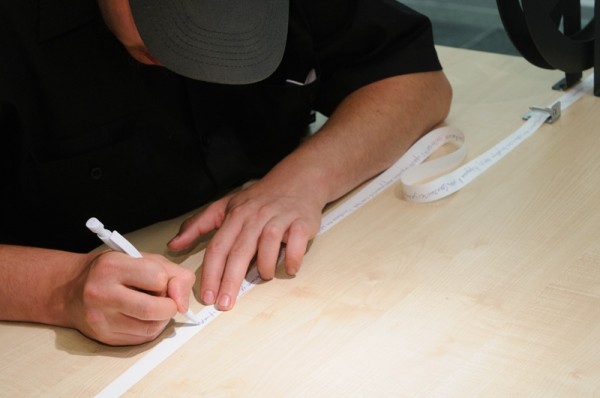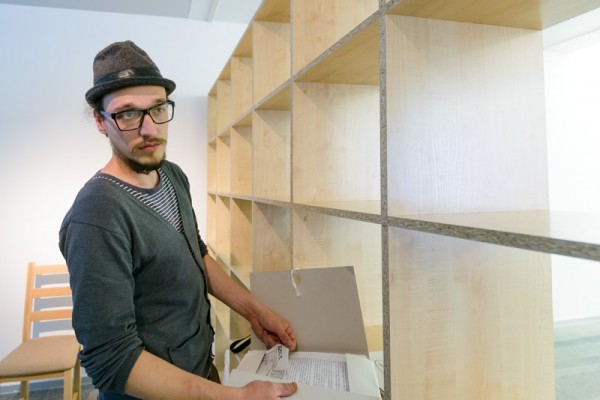Tuesday through Sunday from 12:00 until 21:00
Closed Monday
Admission is Free

Open Group in conversation with Tatiana Kochubinska

Tatiana Kochubinska: What was your reaction to the idea of reconsideration in general and to the ‘Re-consideration’ exhibition project that presupposes searching for interconnections between the young artists of today and the work of an older generation?
Open Group: In fact, we always reconsider our creative work. As we were preparing for the exhibition, we focused on influence rather than reconsideration. Direct influence is really important.
TK: Partly, though, reconsideration is constituted by the analysis of influences.
OG: When we were initially considering the project aimed specifically at the ‘task’ of reconsideration, we wanted to select one particular artist. However, we encountered a problem: there are five of us in the group, and everyone has been influenced by different artists and circumstances. One way or another, everything impacts us. It is impossible to point out particular works. We feel that the practice of the Kollektivnye Deystviya (Collective Actions)[1]group is close to what we are doing. On the other hand, the realization of this fact comes post factum. Thus, first of all, we tried to understand who influenced us, who is close to our practice. After a month of thinking on the topic we came to the conclusion that there is no such person. Later we decided that it is more important to find out which representative of the older generation we would like to work with rather than to discover whose work is close to ours.

TK: How did you choose Yuriy Sokolov as your partner?
OG: In the last six months, even before we were invited to create an exhibition at PinchukArtCentre, we had been in contact with Yuriy Sokolov and had collaborated with him a lot – in particular, as we were working on the Open Archive. Inviting him to join the Open Group was an extremely logical step. He belongs to the older generation, he is someone whose works we like, and he is the person we are interested in working with.
TK: When did you first meet him in person? Have you seen his works?
OG: КThis is different for each member of the group. Somebody, for instance, saw his performance at the first Topical Art Week in Lviv for the first time. In general, in the last few years V. Kaufman, P. Kovach (Senior), G. Kosavan, S. Yakunin referred us to Sokolov when we wanted to get to know something. If you want to know anything, go to Sokolov, ask Sokolov, Sokolov 'has it all'. Yet no one knew anything for sure. Someone even said Sokolov was already dead. Also, Anton Varga invited Yuriy Sokolov to write a piece for the second Aorta[2].
TK: In other words, Sokolov became a certain legend?
OG: Yes, a legend everyone directed us to. For example, O. Furdiyak wrote that if Sokolov and Yakunin are present at a performance event, than it is surely a success. On the whole, there are many coincidences connecting us with Sokolov. We opened Yefremova 26 gallery[3], and Sokolov lives next door. Sokolov comes to the opening of Detenpyla[4], gallery, and it turns out that Olexandr Zamkovetsky’s[5], studio was there before and that performances were made there 20 years ago. This is coincidental and non-coincidental at the same time.
TK: Therefore, you worked in mythologized places, rediscovering them at the same time?
OG: Yes, the places which were forgotten. Unconsciously, we reconsidered them and gave new life to these places. However, we got to know about this post factum

TK: Leaving this mythologization aside, what do Sokolov’s and your own artistic practices have in common?
OG: Long duration, documentation materials, the idea of artist’s permanent presence. Everything is changed when the artist is present. This presence itself is very important, although at the first glance it transforms nothing. Sokolov’s presence and the myth surrounding him are really powerful. For instance, in an article published by Lviv Institute of Topical Art it was stated that Sokolov is a practitioner of "life art". What is "life art"? It was very difficult to understand. For instance, you see Sokolov with three large books, heavy tomes which he appears to have brought in order to give them to someone, but has seemingly forgotten to do this. Then he sits down on the books and begins to smoke. What does it mean? Is this life art, that is, life transferred into art? And we were continually transforming, rethinking this mystery of "life art". He taught us to appeal to the simplest things, everyday things in art. Sokolov claims there is no art, there is just life.
TK: How did he react when you invited him to join the Open Group?
OG: "To make me a part of the Open Group? I already am a part of it!" He finds working with our group interesting because we have similar gallery projects[6]. He has organized and curated exhibitions[7]. We were interested in finding out who had done that before us and in meeting this person, and he needed people of the younger generation who would, in a way, continue his ideas, though at a different level. He gives us one thing, we give him another. There is an exchange as well as mutual influence.

TK: So the idea behind the ‘Biography’ project has already been born in your conversations with Sokolov?
OG: Yes. We have imposed a restriction upon ourselves – that this is going to be a new project with Yuriy Sokolov – in order to avoid using any previous ideas. During many conversations we showed each other all our projects, examining the immediate reconsideration of influences. In the first month of our collaboration with Sokolov we only reflected on the influence everything has on everything else. We told him about our unrealized ideas, and he talked about his works. We discussed diaries at length, and that is how the project started to develop.
TK: Now when all this has developed into an exhibition, you are aware that, to a certain extent, you give every participant a chance to create a myth about themselves?
OG: Either to create a myth or to tell the sincerest truth. With the participants’ help we actually start pondering what biography and influence are, since every person is an influence. When you read the biographies of different people, you see different manners of thought, perceive every new biography as another way of thinking. Some biographies have similarities yet differ in structure or emphasize different things. Observing this is really interesting. Viewers are unable to understand this.

TK: As a matter of fact, however, you do not have viewers –all of them are participants who make it possible for this project to take place.
OG: There are different categories of visitors. At the beginning we actively engaged, practically touched the viewer. Later on, though, during our performance we resorted to watching the viewers, the way they simply watch at first, pick up folders from the "archive", cannot decide what it is that they want, choose random stories – and then ask us whether they can join. Biography is our first project that involves working with so many people and that is aimed at contemplation rather than at resolving conceptual artistic questions. It is a real open archive which we are contemplating. It is the immediate influence of the audience upon the project’s development. Someone has written a biography, and you go to see it. This process, and the peoples’ biographies themselves, influence our gestures.
TK: Tell about the gestures.
OG: At this stage, a letter to a life-term prisoner, a man whose biography is predictable, has become the key gesture. We get this idea, write the letter, edit it. And then the question arises: what is he imprisoned for? We have no confirmed information on that. Yet we are writing to this person, and he becomes a part of the Open Group. This gesture made us reflect on the Open Group itself. If, for example, we see universe as a unified whole, then a group dissociates from something. It is like open and closed doors, we create a group, that is, isolate ourselves from others; there is the Open Group and then there are the rest of people, but we say that everyone can be in the group. This is very strange. Whether the prisoner writes back or not, he is now in the Open Group. As Kharms says in one of his texts, 'you are a part of the world'; similarly, the prisoner is a human being like all of us. This became the most outstanding instance of reconsideration in our project.

TK: You have been continuously writing and reading, writing and reading, writing and reading for three weeks already. What does it give to you personally?
OG: We create the values of this project during its development. It is impossible to single out main or secondary points. The biographies are continued in real life when other viewers read them. Actually, we introduce people to their surrounding, to the visitors of the art centre. This is an archive comprising a certain number of stories of different people who are now in various parts of the world and go on with their biographies. These are discoveries we share with others. We do not create – we search for things. We find them and draw attention to them. We read moods. Disappointment, sadness, longing, happiness and so on. We are also considering exhibiting this project after the exhibition is closed, as it demonstrates certain documented moments.
TK: This documentation is very special and important in the context of current events in Ukraine.
OG: Indeed, a significant part of all biographies consists of the refugee stories told by people from the east of Ukraine: "Where I come from, there is a war on now". And we have been thinking about this, about the fact that we continue working on the project in these circumstances. However, when we read the visitors’ comments, it turns out they state that this is 'a humanistic project which reminds us that people are not numbers'. The credit for this, though, should not be given to us – it belongs to our visitors. We expected many matter-of-fact biographies similar to CVs, but the project demonstrates the opposite: people see themselves as something more than a collection of dry facts.